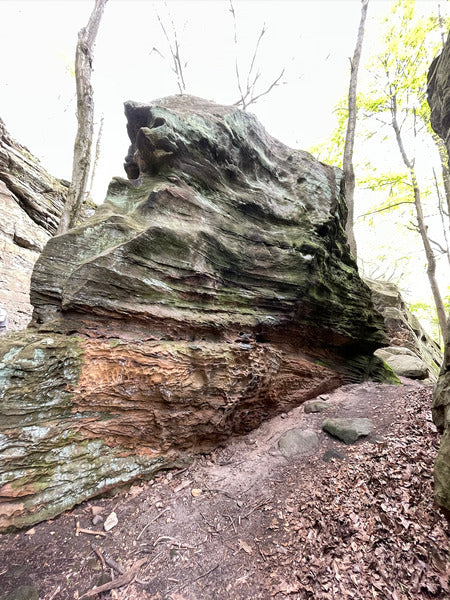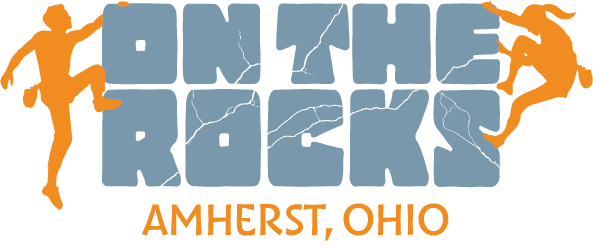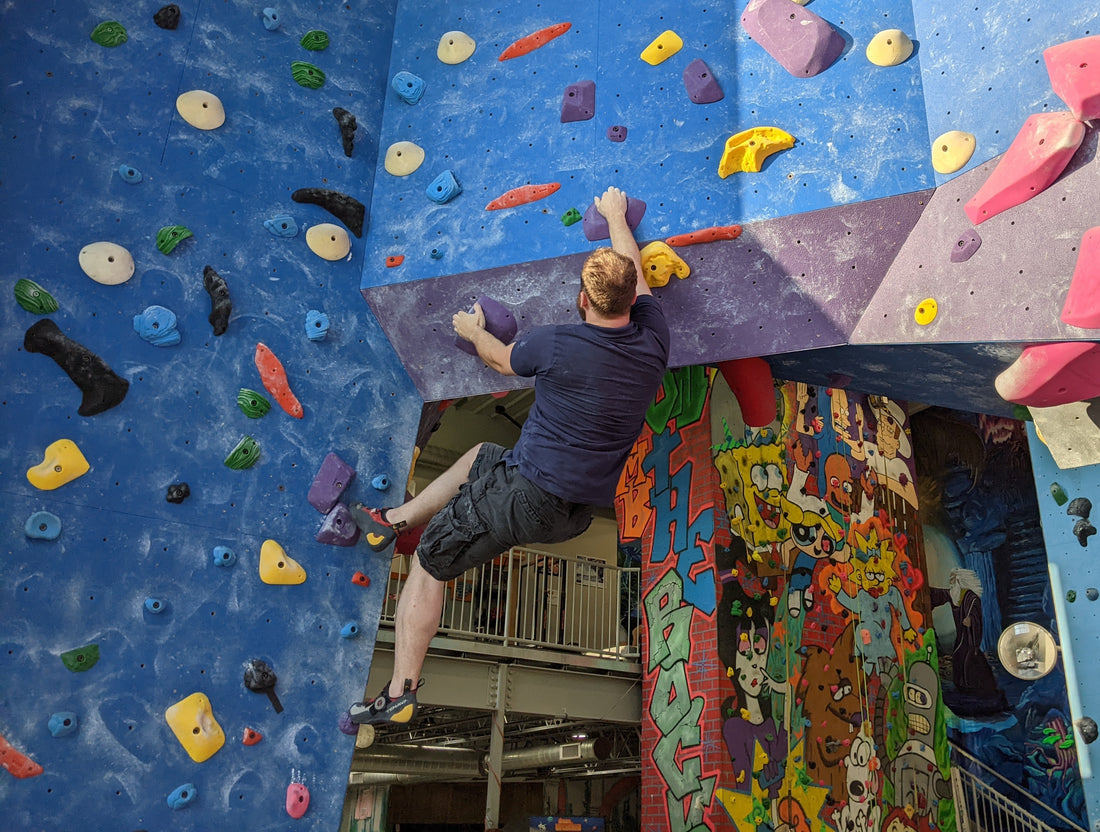What is Bouldering?
Bouldering is a unique form of rock climbing that focuses on climbing short routes close to the ground, called "problems," without the use of ropes or harnesses. As a subtype of climbing, bouldering emphasizes powerful and dynamic movements on smaller rock faces and boulders.
Bouldering differs from standard roped climbing in a few key ways:
- No ropes - Unlike rock climbing, bouldering does not require ropes, harnesses, anchoring equipment or belay partners. The short route lengths and close proximity to the ground make ropes unnecessary.
- Limited height - Bouldering problems are generally less than 20 feet tall, although some test-piece problems can range up to 30+ feet. This allows climbers to jump back to the ground or fall onto crash pads safely if they come off the wall.
- Powerful moves - With its explosive, powerful sequences on smaller holds, bouldering focuses more on finger strength, lock off strength, grip endurance and dynamic movements compared to endurance-focused roped climbing.
In summary, bouldering is a discipline of climbing completed without ropes on shorter climbing routes, relying on crash pads and spotters to protect any falls. The sport tests a climber's power, strength and creativity on a sequence of ascending moves called "problems."

Bouldering Basics
As a simpler form of climbing without ropes or partners, bouldering requires very little gear. Here is an overview of bouldering basics:
Crash Pads
Crash pads, including organic pads made from woodchips or foam pads, are placed underneath problems to cushion any falls. Quality pads provide a thick, firm layer of shock-absorbing foam.
Chalk
Climbers apply gymnast's chalk to their hands to wick away sweat and increase friction on the holds. Good friction helps grip smaller holds on problems.
Climbing Shoes
Tight-fitting, downturned climbing shoes enable advanced footwork and painful toe hooking technique. Beginners can start with neutral flat-profile shoes.
Spotters
Experienced climbers often act as spotters, strategically standing ready to assist if the climber falls awkwardly. Spotting helps minimize injury risk.
With these basic provisions, bouldering requires no specialized gear beyond climbing shoes, chalk and crash pads. The simplicity makes it an accessible way to begin climbing.
Check out this "Boulder of the Week" climbing route at On The Rocks Climbing Gym!
Types of Bouldering
Bouldering can be performed on either artificial indoor walls or natural outdoor bouldering areas. Each type of terrain offers unique features.
Indoor Bouldering Walls
Indoor climbing gyms contain modular walls with sculpted holds that are changed routinely to create fresh "problems" to solve. Key features include:
- Textured polyurethane resin holds in various shapes
- Steep overhanging sections
- Vertical and slab sections
- Cave-like hollows, ridges and 720 degree walls
- Traverse/roof problems test side-to-side climbing
Indoor bouldering walls allow climbing in a controlled environment regardless of weather conditions outside. Route setters dynamically change the paths and handhold challenges to keep problems exciting and unpredictable for a gym's membership.

Outdoor Bouldering
Outdoor bouldering takes advantage of natural rock formations and boulders to create an infinite variety of problems utilizing unique rock features. Common examples include:
- Pockets - shallow holes providing spaces for hands/fingers
- Slopers - subtle, smooth angled holds requiring controlled grips
- Crimps - shallow, crimped ledges for fingertips
- Pinches - protruding ledges to grip between thumb and fingers
- Dynos - dynamic lunging movements between holds
Popular outdoor bouldering areas like Fontainebleau feature sandstone with sculpted edges, encouraging creative hand movements. Granite like the boulders of Joshua Tree offer flakes, cracks and knobs. Limestone can feature stalactite-like formations, adding overhung terrain. Search in your area from some nice outdoor local bouldering locations.
Near our climbing gym outside of Cleveland, we have a great outdoor bouldering location called Whipps Ledges.

The diversity of outdoor rock generates ever-changing bouldering challenges to test a climber's creativity and technique.
See Also:
Bouldering Grading Systems
To quantify the difficulty of bouldering problems, climbers use grading systems like the Hueco V-Scale and Fontainebleau scale. These systems help orient climbers to appropriate challenges.
V-Scale
The most common bouldering grading scheme is the V-Scale, known as the Hueco scale, ranging from V0 to V17. The general difficulty levels are:
- V0-V1 - Beginner
- V2-V3 - Novice
- V4-V5 - Intermediate
- V6-V8 - Advanced
- V9+ - Expert
The V grade measures the hardest single move on a boulder problem, assessing its technical difficulty. Hard problems feature small, slopey or vague holds requiring significant grip strength and accuracy. Higher V grades also demand greater dynamic power for long reaches between holds.
Fontainebleau Scale
A second bouldering grade is France's Fontainebleau circuit scale. It uses numerical grades of 1 through 9, further subdivided with letters A through C. An approximate conversion is:
- Font 4C ~ V0
- Font 6A ~ V3
- Font 7A ~ V5
- Font 8A ~ V9
The Font scale distinguishes between the technical skill needed versus pure physicality. For example, a Font 7A may require less grip strength than other V5s but more balance finesse. Font grades help assess technique mastery.
Understanding grading systems allows climbers to assess the degree of finger/arm strength, flexibility, and mastery of body positioning required to stick a sequence of ascending moves. Hard problems also demand a high level of mental focus.
Bouldering Techniques

Maneuvering up the rock face in bouldering relies on mastering several key techniques to make progress on problems. Core techniques include:
Smearing
Pressing the rubber toes or edges of climbing shoes directly onto the rock to create "friction footing" in the absence of holds. Smearing allows climbers to ascend slabs.
Stemming
Spanning the body between two footholds and applying oppositional pressure between feet to open up the core and keep balance on the wall. Useful on corners.
Heel Hook/Toe Hook
Hooking a heel or toe onto a hold/ledge to take weight off the arms. Enables new body positions.
Mantling
Pressing down forcefully on a ledge with an open palm to lift the body upwards in a burst. Useful getting over short roofs.
Dyno
Launching dynamically for a distant hold, catching it at peak reach. Dynos build explosive power and leaping confidence.
Mastering these essential techniques establishes solid climbing fundamentals. They allow creative movements up, across and through varied boulder problems.
Beginner Bouldering Tips
For climbers just getting started with bouldering, key tips include:
- Start attempting easy problems (V0-V2 level) to build confidence.
- Rent or buy downturned climbing shoes for better precision on footholds.
- Apply gymnast's chalk to hands before climbs to absorb sweat.
- Learn how to properly spot climbers to provide support if they fall.
- Focus on mastering smearing, stemming, weight distribution and balance before powering through problems.
- Stretch after climbing to aid recovery between attempts on problems.
With practice developing essential techniques, novice climbers can smoothly work their way into intermediate and advanced problems.

Bouldering Training
As climbers progress in the sport, targeted strength and conditioning helps tackle more difficult problems. Key elements of a bouldering training regimen include:
Finger Strength
Hangboards and fingerboards allow isolated finger strength training on an array of narrow ledges and pockets. Adding small weights assists in progressive overload.
Core Exercises
A strong core stabilizes body positioning and weight distribution on the wall. Planks, hollow holds, and hanging leg raises build a solid foundation.
Flexibility Drills
Bouldering demands extensive reach on dynamic problems. Stretching routines grow reach and enhance recovery.
Endurance Training
Campusing drills and 4x4s (climbing 4 boulder problems back-to-back without rest) build enduring power for longer sequences between rests.
Antagonist Training
Exercises like wrist curls that extend the forearms counterbalance intensive crimping and prevent muscle imbalances or injury.
Dedicated supplemental training allows boulderers to break into higher grade problems that require advanced finger dexterity, core tension and explosive power in a controlled way. Training safely is key to continuous progression.
Is Bouldering Safe?
Despite its perceived risks, bouldering offers a reasonable level of safety thanks to crash pads and spotters. However, climbers should be aware of several factors:
- Spotters help prevent injuries but cannot eliminate risk entirely from an inherently dangerous sport.
- Inadequate crash pads increase chance of collisions with the ground.
- Poor technique like uncontrolled dynamic movements can lead to finger tweaks or blown shoulders.
- Overtraining and trying to progress too quickly often ends in finger pulley issues or popped tendons from large loading.
Bouldering sees an estimated 0.2-5.0 injuries per 1,000 hours of climbing time - fewer than sports like football or gymnastics. While not 100% safe, attention to proper fall procedures, graduated training, and controlled technique offer a substantial safety net. Understanding how to mitigate risks keeps the sport enjoyable long-term.

Conclusion
Bouldering offers a uniquely engaging form of climbing powerful problems close to the ground. As one of climbing's simplest disciplines, requiring little gear beyond shoes and chalk, bouldering focuses on demonstrating gymnastic strength, advanced technique like heel hooks and dynos, plus mental creativity in navigating short sequences.
With both indoor and outdoor options, bouldering's flexibility and minimal gear needs make it widely accessible. Bouldering redefines climbing skill as being less about sheer endurance and more about distilled power. For many climbers, the puzzle-like challenges of "problem solving" boulder routes make it a preferred vertical discipline. As the purest expression of power and movement mastery, bouldering will continue gaining devotees drawn to its test-piece nature.

